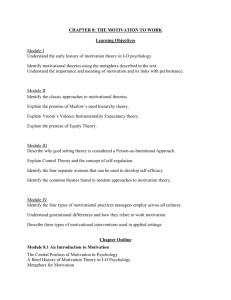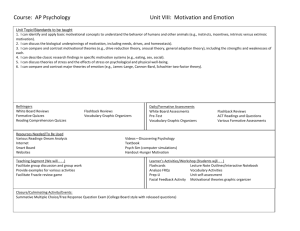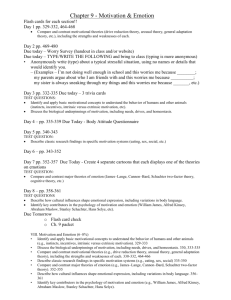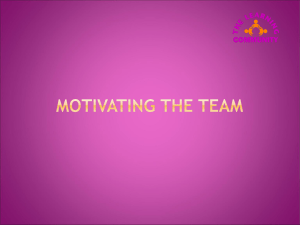CHAPTER 8: THE MOTIVATION TO WORK
advertisement
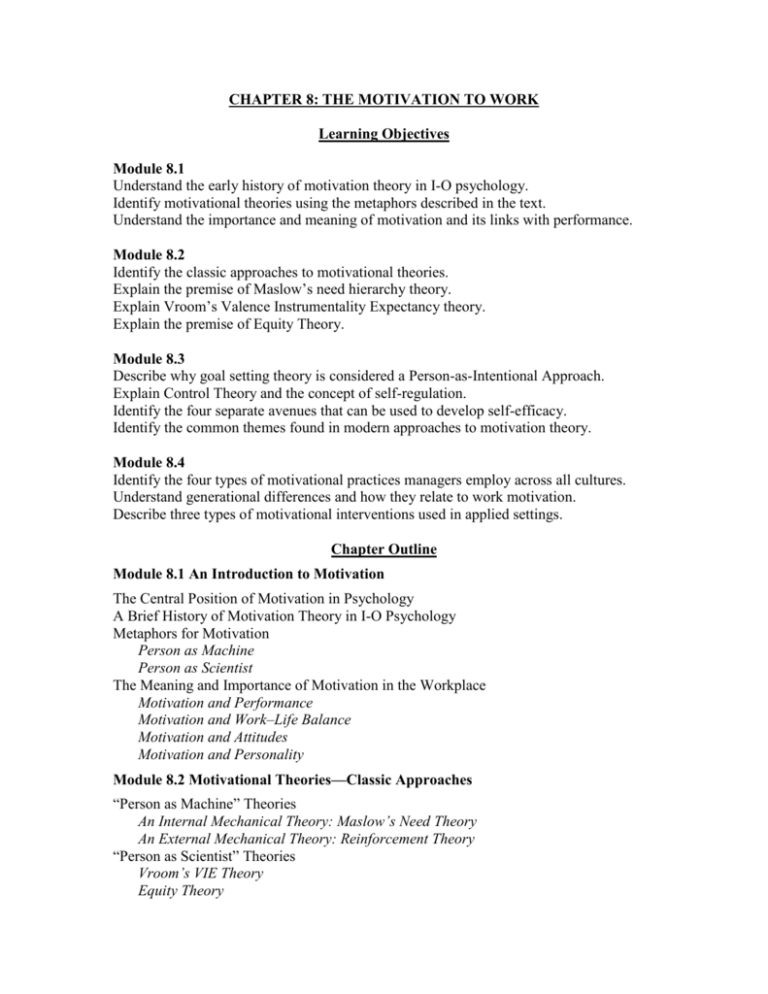
CHAPTER 8: THE MOTIVATION TO WORK Learning Objectives Module 8.1 Understand the early history of motivation theory in I-O psychology. Identify motivational theories using the metaphors described in the text. Understand the importance and meaning of motivation and its links with performance. Module 8.2 Identify the classic approaches to motivational theories. Explain the premise of Maslow’s need hierarchy theory. Explain Vroom’s Valence Instrumentality Expectancy theory. Explain the premise of Equity Theory. Module 8.3 Describe why goal setting theory is considered a Person-as-Intentional Approach. Explain Control Theory and the concept of self-regulation. Identify the four separate avenues that can be used to develop self-efficacy. Identify the common themes found in modern approaches to motivation theory. Module 8.4 Identify the four types of motivational practices managers employ across all cultures. Understand generational differences and how they relate to work motivation. Describe three types of motivational interventions used in applied settings. Chapter Outline Module 8.1 An Introduction to Motivation The Central Position of Motivation in Psychology A Brief History of Motivation Theory in I-O Psychology Metaphors for Motivation Person as Machine Person as Scientist The Meaning and Importance of Motivation in the Workplace Motivation and Performance Motivation and Work–Life Balance Motivation and Attitudes Motivation and Personality Module 8.2 Motivational Theories—Classic Approaches “Person as Machine” Theories An Internal Mechanical Theory: Maslow’s Need Theory An External Mechanical Theory: Reinforcement Theory “Person as Scientist” Theories Vroom’s VIE Theory Equity Theory Module 8.3 Modern Approaches to Work Motivation Person-as Intentional Approaches Goal-Setting Theory Control Theories and the Concept of Self-Regulation The Concept of Self-Efficacy in Modern Motivation Theory Action Theory Common Themes in Modern Approaches A New Motivational Topic: The Entrepreneur Module 8.4 Practical Issues in Motivation Can Motivation Be Measured? Cross-Cultural Issues in Motivation Generational Differences and Work Motivation Motivational Interventions Contingent Rewards Job Enrichment ProMES Glossary Terms for Chapter 8 This list of key terms and important concepts from Chapter 8 can be used in conjunction with reviewing the material in the textbook. After reviewing Chapter 8 in the textbook, define each of the following key terms and important concepts fully. Check your answers with the textbook, and review terms with which you have difficulty. Good luck! Module 8.1 motivation instinct need drive behaviorist approach Field Theory group dynamics “person as machine” metaphor “person as scientist” metaphor limited rationality “person as judge” metaphor work-life balance attitudes Module 8.2 Maslow’s need theory Two-factor theory hygiene needs motivator needs reinforcement theory contingent reward intermittent reward continuous reward VIE theory Path-Goal theory of Motivation valence instrumentality expectancy equity theory Dissonance Theory inputs outcomes comparison other outcome/input ratio Module 8.3 person-as-intentional approach Goal Setting Theory feedback loop control theory self-regulation self-efficacy Action Theory (Rubicon Theory) action process action structure Module 8.4 Motivational Trait Questionnaire (MTQ) job enrichment ProMES indicators Class Ideas for Chapter 8 1. An interesting article in the New York Times in “Economic Scene” by Alan Krueger (June 26, 2003) presents some examples of "cognitive behaviorism" and limited rationality that are related to motivational themes discussed in this chapter. 2. The Industrial-Organizational Psychologist (TIP) articles of interest: Cascio, W.F. (October 2006). The new human capital equation. The IndustrialOrganizational Psychologist, 44 (2), 15-22. (Discusses how to reduce employee turnover and produce the most human capital by keeping employees motivated & happy.) Church, A.H. (July 2006). Talent management. The Industrial-Organizational Psychologist, 45(1), 35-36. (Discusses how to motivate and maintain talented employees) Rucci, A. (July 2008). SIOP keynote address: I-O psychology’s “core purpose”: where science and practice meet. The Industrial-Organizational Psychologist, 46 (1), 17-24. (Article discusses recent research on the 3 factors that motivate employees to enhance organizational performance) Debate Topic: - Which is a stronger motivator, money or power? Critical Thinking Exercises (CTEs) 8.1 People engage in many dangerous behaviors, including smoking, substance abuse, driving without seatbelts, etc. How can these behaviors be accounted for using the “person-as-machine” metaphor? 8.2 Competitive individuals are often described as having a “fire burning inside.” Would this explanation be more compatible with instinct theory, the “person-as-machine” metaphor, or the “person-as-God-like” metaphor? Why? 8.3 During the summer of 2002, a drought in the southwest led to many forest fires. Several of these fires were set intentionally by part time fire fighters anxious to make additional money. Apply two classic theories of motivation to this behavior. 8.4 The stars of TV shows often threaten to leave the show unless they are paid more money per episode, even though they are making a substantial per-episode salary already. The stars of “Friends” make more than $1 million per episode. Using either Equity Theory or Vroom’s VIE theory, explain the tendency among these stars to ask for more money. 8.5 Many top level executives have pay packages which are tied to the value of the company’s stock. As the stock price goes up, the executive’s bonus goes up. This has been identified as one possible reason for the recent scandals involving the overstatement of corporate earnings in order to drive stock prices higher. How could goal setting theory be used to alter this method of compensation? 8.6 Recall the last time you did more poorly than you had expected to in an examination. Using the feedback loop concept of control theory, describe how you altered your behavior to prepare for the next examination in that subject matter. 8.7 Assume that as a manager of a fast food restaurant, you wanted to increase the cleanliness of the seating area by having your staff be more attentive to that area. Using a program of contingent rewards, how would you do that? Is there any research evidence to support your plan? 8.8 ProMES has been used successfully as a method of motivation in well over a dozen countries. What characteristics of ProMES make it suitable for crossing cultural boundaries? In which country/culture do you think ProMES would work particularly well? Why? In which country/culture do you think ProMES would work particularly poorly? Why?
